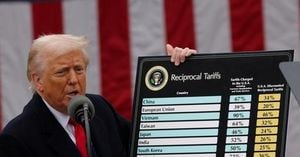On September 17 and 18, 2025, financial markets across the globe experienced a whirlwind of news, from a bold $4 billion capital raise by Forward Industries to the U.S. Federal Reserve’s first interest rate cut of the year and dramatic swings on the Vietnamese stock market. Each of these events, while unfolding in different corners of the financial world, painted a vivid picture of shifting strategies, economic uncertainty, and the ever-present dance between risk and opportunity.
Forward Industries, a Nasdaq-listed company, made headlines by filing for a massive $4 billion stock offering aimed at expanding its Solana (SOL) treasury. According to Solan Forward, the company’s plan is to use the funds for liquidity and to further accumulate SOL tokens, enlisting Cantor Fitzgerald as its agent. This move would more than double the $3.1 billion currently held by Solana treasury companies worldwide—a staggering leap that signals both ambition and confidence in the cryptocurrency’s future.
The announcement, however, sent Forward Industries’ (FORD) shares tumbling. The stock dropped 8.2%, settling at $34.28 after briefly touching $31.29. This volatility underscored the market’s mixed feelings: Was this an inspired bet on digital assets, or a risky overreach?
Forward Industries isn’t new to bold moves. As Solan Forward detailed, the company had previously secured $1.65 billion in private investments from heavyweights like Galaxy Digital, Jump Crypto, and Multicoin Capital. With those funds, Forward acquired 6.82 million SOL tokens at an average price of $232, making it the largest public Solana treasury holder. As of now, it holds about $1.6 billion in SOL tokens—outpacing all other public treasury companies in the sector.
Kyle Samani, the company’s chairman, stressed the flexibility gained through this capital raise. "The offering enables flexible capital deployment to expand Solana's position," he explained, highlighting the automatic registration mechanism that allows shares to be sold immediately after legal requirements are met. This approach, as noted by Solan Forward, mirrors the successful Bitcoin treasury strategy pioneered by MicroStrategy—a move that has inspired other firms, including DeFi Development Corp., to register similar offerings with the SEC.
The new preferred stock, labeled as Perpetual Accumulating Preferred Stock Class C, promises quarterly dividends at a fixed (but so far undisclosed) rate. This structure is reminiscent of strategies used by leading Bitcoin treasury companies, aiming to attract investors seeking both crypto exposure and regular income.
The market for SOL tokens, meanwhile, remains vibrant. SOL is currently trading at $235.45, with analysts predicting a 90% chance it will reach $250 before any significant decline to $130. The token has risen 1.2% in the past 24 hours, buoyed by growing institutional interest. Forward’s aggressive expansion, it seems, is both a response to—and a driver of—this institutional momentum.
While Forward Industries was making waves in the crypto world, the U.S. Federal Reserve was sending ripples through traditional markets. On September 17, after a two-day policy meeting, the Fed announced its first monetary policy adjustment of 2025: a 25 basis point cut, bringing the benchmark interest rate to 4-4.25%. This decision, as reported by Reuters, aligned with market expectations, but not everyone was in agreement. Only one board member, Stephen Miran, dissented—he pushed for a steeper, 50 basis point reduction.
The Fed’s move followed three consecutive rate cuts in 2024, after which policymakers had paused to assess inflation and labor market trends. The impetus for the latest cut was multifaceted: economic activity had slowed in the first half of the year, job growth had decelerated, unemployment had ticked up (though it remained low), and inflation was running high. The Fed’s statement after the meeting summed it up: "Recent data show economic activity has slowed in the first half of the year. Job growth has also slowed, unemployment has edged up but remains low. Inflation has accelerated and remains quite high."
Looking ahead, the Fed projected another 50 basis points in cuts before year’s end, with smaller reductions in 2026 and 2027. Their forecasts also included 1.6% GDP growth for 2025 (up from a previous estimate of 1.4%), an unemployment rate of 4.5% by year-end, and Personal Consumption Expenditures (PCE) inflation at 3% for 2025, easing to 2.6% in 2026.
The impact of the rate cut was immediate but uneven. Major U.S. stock indices initially rose, only to reverse course: the Dow Jones Industrial Average gained 0.7%, while the S&P 500 and Nasdaq Composite slipped 0.3% and 0.6%, respectively. Gold prices soared to a record $3,708 an ounce before retreating slightly. The policy meeting itself was described as unprecedented, given recent changes to the Fed’s board and mounting political pressure from President Donald Trump, who had recently imposed new import taxes and sought to influence the Fed’s decisions.
On the same day as the Fed’s announcement, Stephen Miran was confirmed as a temporary board member, and a court ruled that Fed Governor Lisa Cook could not be dismissed by the president over mortgage fraud allegations. These developments added a layer of political drama to an already tense economic moment.
Meanwhile, on September 18, the Vietnamese stock market faced its own turbulence. As reported by VCBS and other local brokerages, the VN-Index was hammered by heavy selling pressure, dropping to 1,670 points and even briefly touching 1,660. The main culprits? Banking, securities, and steel stocks, which all traded deep in the red. The index managed to hold its support zone (1,660-1,670 points, corresponding to the 20-day moving average) largely thanks to the strength of Vingroup’s flagship stocks, VHM and VIC.
VIC, in particular, soared to near its ceiling price, setting a new record and becoming the market’s largest capitalization stock. Technical indicators like RSI and MACD pointed to a short-term correction, with analysts predicting further declines toward the Senkouspan B cloud line at 1,660 points. Despite the sell-off, most securities firms remained optimistic about the market’s prospects for the rest of 2025. VCBS, for example, projected a base scenario of 1,672 points and an optimistic scenario of 1,854 points by year-end, citing hopes for a market upgrade, aggressive growth policies, and diplomatic advances.
Investor sentiment on September 18 was notably cautious, leading to fragmented trading and only a mild rebound in the VN-Index, again thanks to Vingroup stocks. While banking and securities shares languished, the trio of VHM, VIC, and VRE managed gains of 3-4%. Still, the broader market couldn’t hold onto early gains, with most sectors ending in the red—except for real estate and construction, which rose more than 1.5% on the back of Vingroup’s performance.
From Wall Street to Ho Chi Minh City and the digital corridors of the crypto world, these past two days have underscored just how interconnected—and unpredictable—global finance can be. Whether it’s massive bets on blockchain, central banks navigating political headwinds, or local markets wrestling with short-term volatility, one thing is certain: the only constant is change.




